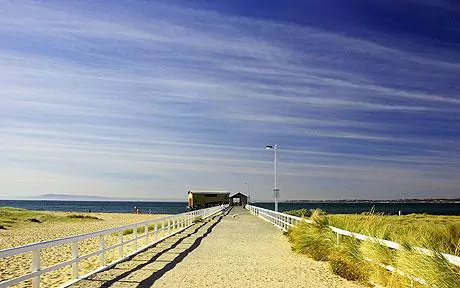Population 1,416 (2006 census) Postal code 3225 | Postcode(s) 3225 Elevation 15 m Local time Tuesday 8:38 PM | |
 | ||
Weather 19°C, Wind SE at 23 km/h, 98% Humidity Points of interest Fort Queenscliff, Bellarine Railway, Queenscliff High Light, Queenscliffe Maritime Museum, Queenscliff Harbour | ||
Queenscliff is a small town on the Bellarine Peninsula in southern Victoria, Australia, south of Swan Bay at the entrance to Port Phillip. It is the administrative centre for the Borough of Queenscliffe. At the 2006 census, Queenscliff had a population of 1,416.
Contents
- Map of Queenscliff VIC 3225 Australia
- History
- 1880s seaside resort boom
- Decline
- Revival
- Heritage listed sites
- Festivals
- Museums
- Sport
- Media
- Transport
- References
Map of Queenscliff VIC 3225, Australia
Queenscliff is a former 1880s seaside resort now known for its Victorian era heritage and tourist industry and as one of the endpoints of the Searoad ferry to Sorrento on the Mornington Peninsula.
History
Prior to European settlement, it was inhabited by the Bengalat Bulag clan of the Wautharong tribe, a member of the Kulin nation.
European explorers first arrived in 1802, Lieutenant John Murray in January and Captain Matthew Flinders in April. The first European settler in the area was convict escapee William Buckley between 1803 and 1835, for a short time in a cave beneath the Point Lonsdale Lighthouse, with the local Aborigines.
Permanent settlement began in 1836 when squatters arrived. Shortland's Bluff was named in honour of Lieutenant John Shortland, who assisted in the surveying of Port Phillip. Land sales began in 1853, the same year the name was changed to Queenscliff by Lieutenant Charles La Trobe, in honour of Queen Victoria.
The Post Office opened on 1 May 1853 as Shortland's Bluff and was renamed Queenscliff in 1854.
Originally a fishing village, Queenscliff soon became an important cargo port, servicing steamships trading in Port Philip. A shipping pilot service was established in 1841, and its two lighthouses, the High and Low Lights, were constructed in 1862-63. Queenscliff also played an important military role. Fort Queenscliff was built between 1879 and 1889, and operated as the command centre for a network of forts around the port.
1880s seaside resort boom
Queenscliff became a tourist destination in the late 19th century, with visitors arriving from Melbourne after a two-hour journey on the paddle steamer, Ozone. The opening of a railway line to Geelong in 1879 brought increasing tourists to the area, and numerous luxury hotels (or coffee palaces) were built to accommodate them. The Palace Hotel was built in 1879 (later renamed Esplanade Hotel), the Baillieu Hotel was built in 1881 (later renamed Ozone Hotel), the Vue Grande Hotel was built in 1883, and the Queenscliff Hotel was built in 1887.
Decline
The advent of the car saw Queenscliff drop in popularity as a tourist destination, as tourists were no longer dependent on its role as a transport hub. The railway ceased weekly passenger services in 1950, and was closed in 1976.
Revival
The 1980s saw a return in the town's tourist popularity.
In 2005, the area previously holding the Fort Barracks was subdivided into residential blocks and renamed Shortlands Beach in honour of the town's prior name. The proposed redevelopment drew fierce criticism from some sectors of the community, who feared loss of an important heritage site. The original fort remains on site.
Heritage listed sites
Queenscliff contains several Victorian Heritage Register listed sites, including:
Festivals
The Queenscliff Seafood Feast, a culinary festival using fresh seafood donated by local fishermen, is held annually on Good Friday to raise funds for the Royal Children's Hospital.
Queenscliff is also home to the Queenscliff Music Festival, a popular annual music festival, held on the last weekend of November, which attracts both local and international acts and is an important part of the town's tourist industry.
Museums
Queenscliff has three museums, the Queenscliff Historical Museum, Queenscliffe Maritime Museum, and the Fort Queenscliff Museum.
Sport
The Queenscliff Football Club is the town's Australian rules football club which participates in the Bellarine Football League.
Golfers play at the course of the Queenscliff Golf Club at Swan Island.
Media
The Queenscliffe Herald was founded in 1999 by Greg Wane who edited and managed the newspaper until 2004 when the Murphy family bought the masthead and continue to publish the newspaper. The final elimination on the second season of The Mole took place here in late 2000.
Transport
As it is located on a peninsula, the Bellarine Highway is the only road connecting it to Point Lonsdale and Geelong running west.
It is best known as being one of the endpoints of the Searoad ferry to Sorrento on the Mornington Peninsula. It is also the terminus of the Bellarine Peninsula Railway.
It was once connected by railway to Geelong, however the Bellarine Peninsula Railway now runs as a tourist railway only to Drysdale.
Cycling is popular along the former railway - Bellarine Rail Trail.
Queenscliff has also been considered as the future site of the proposed Port Phillip Bay Bridge.
